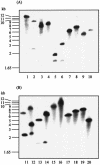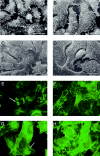Role for flagella but not intimin in the persistent infection of the gastrointestinal tissues of specific-pathogen-free chicks by shiga toxin-negative Escherichia coli O157:H7
- PMID: 15731085
- PMCID: PMC1064906
- DOI: 10.1128/IAI.73.3.1836-1846.2005
Role for flagella but not intimin in the persistent infection of the gastrointestinal tissues of specific-pathogen-free chicks by shiga toxin-negative Escherichia coli O157:H7
Abstract
Shiga toxin (Stx)-positive Escherichia coli O157:H7 readily colonize and persist in specific-pathogen-free (SPF) chicks, and we have shown that an Stx-negative E. coli O157:H7 isolate (NCTC12900) readily colonizes SPF chicks for up to 169 days after oral inoculation at 1 day of age. However, the role of intimin in the persistent colonization of poultry remains unclear. Thus, to investigate the role of intimin and flagella, which is a known factor in the persistence of non-O157 E. coli in poultry, isogenic single- and double-intimin and aflagellar mutants were constructed in E. coli O157:H7 isolate NCTC12900. These mutants were used to inoculate (10(5) CFU) 1-day-old SPF chicks. In general, significant attenuation of the aflagellate and intimin-aflagellate mutants, but not the intimin mutant, was noted at similar time points between 22 and 92 days after inoculation. The intimin-deficient mutant was still being shed at the end of the experiment, which was 211 days after inoculation, 84 days more than the wild type. Shedding of the aflagellar and intimin-aflagellar mutants ceased 99 and 113 days after inoculation, respectively. Histological analysis of gastrointestinal tissues from inoculated birds gave no evidence for true microcolony formation by NCTC12900 or intimin and aflagellar mutants to epithelial cells. However, NCTC12900 mutant derivatives associated with the mucosa were observed as individual cells and/or as large aggregates. Association with luminal contents was also noted. These data suggest that O157 organisms do not require intimin for the persistent colonization of chickens, whereas flagella do play a role in this process.
Figures






Similar articles
-
A comparison of Shiga-toxin negative Escherichia coli O157 aflagellate and intimin deficient mutants in porcine in vitro and in vivo models of infection.Vet Microbiol. 2006 Mar 10;113(1-2):63-72. doi: 10.1016/j.vetmic.2005.10.033. Epub 2005 Dec 7. Vet Microbiol. 2006. PMID: 16337755
-
Non-toxigenic Escherichia coli O157:H7 strain NCTC12900 causes attaching-effacing lesions and eae-dependent persistence in weaned sheep.Int J Med Microbiol. 2003 Aug;293(4):299-308. doi: 10.1078/1438-4221-00264. Int J Med Microbiol. 2003. PMID: 14503794
-
Variable and strain dependent colonisation of chickens by Escherichia coli O157.Vet Microbiol. 2005 Apr 25;107(1-2):103-13. doi: 10.1016/j.vetmic.2005.01.005. Vet Microbiol. 2005. PMID: 15795082
-
Fimbriation and curliation in Escherichia coli O157:H7: a paradigm of intestinal and environmental colonization.Gut Microbes. 2012 May-Jun;3(3):272-6. doi: 10.4161/gmic.20661. Epub 2012 May 1. Gut Microbes. 2012. PMID: 22614704 Free PMC article. Review.
-
Escherichia coli 0157:H7: an update on intestinal colonization and virulence mechanisms.Anim Health Res Rev. 2004 Jun;5(1):15-33. doi: 10.1079/ahr200463. Anim Health Res Rev. 2004. PMID: 15460538 Review.
Cited by
-
Host protein binding and adhesive properties of H6 and H7 flagella of attaching and effacing Escherichia coli.J Bacteriol. 2007 Oct;189(20):7426-35. doi: 10.1128/JB.00464-07. Epub 2007 Aug 10. J Bacteriol. 2007. PMID: 17693516 Free PMC article.
-
The Rcs System Contributes to the Motility Defects of the Twin-Arginine Translocation System Mutant of Extraintestinal Pathogenic Escherichia coli.J Bacteriol. 2022 Apr 19;204(4):e0061221. doi: 10.1128/jb.00612-21. Epub 2022 Mar 21. J Bacteriol. 2022. PMID: 35311558 Free PMC article.
-
Avian pathogenic Escherichia coli: Epidemiology, virulence and pathogenesis, diagnosis, pathophysiology, transmission, vaccination, and control.Vet World. 2024 Dec;17(12):2747-2762. doi: 10.14202/vetworld.2024.2747-2762. Epub 2024 Dec 6. Vet World. 2024. PMID: 39897356 Free PMC article. Review.
-
Mucosally-directed adrenergic nerves and sympathomimetic drugs enhance non-intimate adherence of Escherichia coli O157:H7 to porcine cecum and colon.Eur J Pharmacol. 2006 Jun 6;539(1-2):116-24. doi: 10.1016/j.ejphar.2006.03.081. Epub 2006 Apr 6. Eur J Pharmacol. 2006. PMID: 16687138 Free PMC article.
-
Escherichia coli O157:H7 colonization in cattle following systemic and mucosal immunization with purified H7 flagellin.Infect Immun. 2008 Jun;76(6):2594-602. doi: 10.1128/IAI.01452-07. Epub 2008 Mar 24. Infect Immun. 2008. PMID: 18362130 Free PMC article. Clinical Trial.
References
-
- Allen-Vercoe, E., M. P. Dibb-Fuller, C. J. Thorns, and M. J. Woodward. 1997. SEF17 fimbriae are essential for the convoluted colonial morphology of Salmonella enteritidis. FEMS Microbiol. Lett. 153:33-42. - PubMed
-
- Allen-Vercoe, E., and M. J. Woodward. 1999. Colonisation of the chicken caecum by afimbriate and aflagellate derivatives of Salmonella enterica serotype Enteritidis. Vet. Microbiol. 69:265-275. - PubMed
-
- Besser, R. E., S. M. Lett, J. T. Weber, M. P. Doyle, T. J. Barrett, J. G. Wells, and P. M. Griffin. 1993. An outbreak of diarrhea and hemolytic uremic syndrome from Escherichia coli O157:H7 in fresh-pressed apple cider. JAMA 269:2217-2220. - PubMed
-
- Best, A., R. M. La Ragione, W. A. Cooley, C. D. O'Connor, P. Velge, and M. J. Woodward. 2003. Interaction with avian cells and colonisation of specific pathogen free chicks by Shiga-toxin negative Escherichia coli O157:H7 (NCTC 12900). Vet. Microbiol. 93:207-222. - PubMed
Publication types
MeSH terms
Substances
LinkOut - more resources
Full Text Sources
Other Literature Sources
Medical

